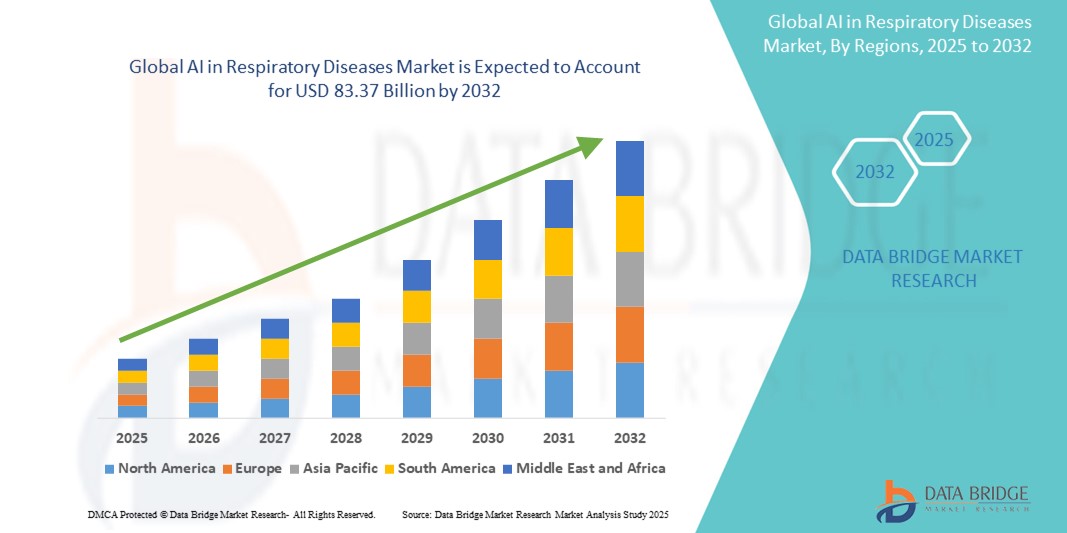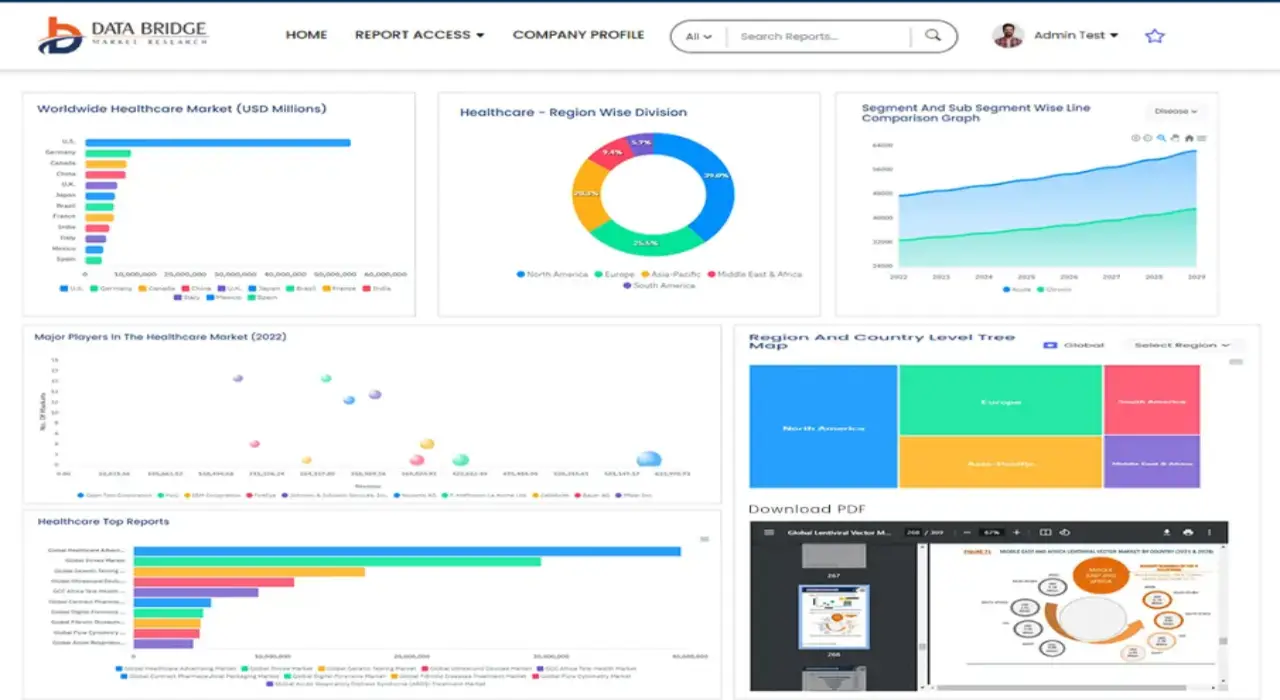Global Ai In Respiratory Diseases Market
Tamanho do mercado em biliões de dólares
CAGR :
% 
 USD
9.10 Billion
USD
83.37 Billion
2024
2032
USD
9.10 Billion
USD
83.37 Billion
2024
2032
| 2025 –2032 | |
| USD 9.10 Billion | |
| USD 83.37 Billion | |
|
|
|
|
Segmentação do mercado global de IA em doenças respiratórias, por indicação (doença pulmonar obstrutiva crônica, doença pulmonar intersticial e infecção pulmonar), tipo de imagem (ressonância magnética, tomografia computadorizada e ePRO), uso final (hospital, centros de diagnóstico, centros cirúrgicos ambulatoriais e outros) - Tendências do setor e previsão até 2032
Tamanho do mercado de IA em doenças respiratórias
- O tamanho do mercado global de IA em doenças respiratórias foi avaliado em US$ 9,10 bilhões em 2024 e deve atingir US$ 83,37 bilhões até 2032 , com um CAGR de 31,90% durante o período previsto.
- O crescimento do mercado é amplamente impulsionado pela crescente prevalência de doenças respiratórias, como DPOC, asma e infecções pulmonares, juntamente com a necessidade de detecção precoce, diagnósticos precisos e planejamento de tratamento personalizado com tecnologia de inteligência artificial.
- Além disso, a crescente demanda por ferramentas eficientes de suporte à decisão clínica, a integração de IA em imagens e análises preditivas e a crescente adoção de tecnologias digitais de saúde em ambientes de cuidados respiratórios estão consolidando a IA como uma força transformadora na medicina pulmonar. Esses fatores convergentes estão acelerando a integração da IA no gerenciamento de doenças respiratórias, impulsionando significativamente o crescimento do setor.
Análise de Mercado de IA em Doenças Respiratórias
- A IA em doenças respiratórias, abrangendo ferramentas avançadas para imagens, diagnósticos e suporte à decisão clínica, está se tornando um componente essencial do tratamento respiratório moderno em hospitais, centros de diagnóstico e instituições de pesquisa devido à sua capacidade de aumentar a precisão do diagnóstico, prever a progressão da doença e oferecer suporte a estratégias de tratamento personalizadas.
- A crescente demanda por IA neste campo é alimentada principalmente pelo aumento da carga global de doenças respiratórias crônicas, como DPOC e infecções pulmonares, pela crescente necessidade de detecção precoce e precisa e pela crescente integração da IA em imagens médicas e plataformas de saúde digital.
- A América do Norte dominou o mercado de IA em doenças respiratórias com a maior participação na receita de 45,1% em 2024, atribuída à sua infraestrutura avançada de saúde, uso generalizado de tecnologias de saúde digital e investimentos robustos em pesquisa de IA, especialmente nos EUA, onde os provedores de saúde estão adotando cada vez mais ferramentas de imagem e modelos preditivos baseados em IA
- Espera-se que a Ásia-Pacífico seja a região de crescimento mais rápido durante o período previsto, impulsionada pela melhoria do acesso à saúde, pelo aumento das despesas com saúde e pelo apoio governamental à integração de IA em ambientes clínicos.
- O segmento de tomografia computadorizada dominou o mercado de IA em doenças respiratórias com uma participação de mercado de 31,6% em 2024, devido ao seu papel central na detecção e monitoramento de condições respiratórias e à integração de algoritmos de IA para análise de imagens, quantificação de doenças e suporte diagnóstico.
Escopo do Relatório e Segmentação do Mercado de IA em Doenças Respiratórias
|
Atributos |
Principais insights de mercado sobre IA em doenças respiratórias |
|
Segmentos abrangidos |
|
|
Países abrangidos |
América do Norte
Europa
Ásia-Pacífico
Oriente Médio e África
Ámérica do Sul
|
|
Principais participantes do mercado |
|
|
Oportunidades de mercado |
|
|
Conjuntos de informações de dados de valor agregado |
Além dos insights sobre cenários de mercado, como valor de mercado, taxa de crescimento, segmentação, cobertura geográfica e principais participantes, os relatórios de mercado selecionados pela Data Bridge Market Research também incluem análises aprofundadas de especialistas, análises de preços, análises de participação de marca, pesquisas com consumidores, análises demográficas, análises da cadeia de suprimentos, análises da cadeia de valor, visão geral de matérias-primas/consumíveis, critérios de seleção de fornecedores, análise PESTLE, análise de Porter e estrutura regulatória. |
Tendências de mercado de IA em doenças respiratórias
“Diagnóstico e suporte à decisão aprimorados por meio da integração de IA”
- Uma tendência significativa e em rápido desenvolvimento no mercado global de IA em doenças respiratórias é a crescente integração da inteligência artificial em ferramentas de diagnóstico por imagem, suporte à decisão clínica e monitoramento de pacientes. Esse desenvolvimento está revolucionando o tratamento pulmonar, permitindo detecção precoce, maior precisão diagnóstica e planejamento de tratamento personalizado.
- Por exemplo, plataformas de análise de TC e raios X aprimoradas por IA, como as da Zebra Medical Vision e da Aidoc, são capazes de detectar automaticamente anormalidades como nódulos, fibrose e inflamação — muitas vezes antes que os sintomas se manifestem — permitindo um gerenciamento mais proativo da doença.
- A IA também está sendo aplicada para prever a deterioração do paciente em tempo real. Soluções como as da Tempus e da Qure.ai utilizam aprendizado de máquina para analisar padrões em dados respiratórios e imagens para orientar as intervenções médicas. Em plataformas de resultados eletrônicos relatados pelo paciente (ePRO), algoritmos de IA são usados para monitorar as informações do paciente e sinalizar potenciais exacerbações ou complicações em condições como DPOC e DPI.
- Além disso, a integração da IA com sistemas de informação hospitalar e plataformas de telemedicina permite que os médicos acessem visualizações consolidadas de imagens, testes de função pulmonar e insights preditivos, simplificando os fluxos de trabalho e aprimorando a tomada de decisões.
- À medida que as ferramentas de IA se tornam mais interoperáveis com os sistemas de radiologia e prontuários eletrônicos existentes, sua adoção está se acelerando em ambientes de saúde urbanos e rurais. Empresas como a GE HealthCare e a Siemens Healthineers estão desenvolvendo diagnósticos respiratórios baseados em IA com opções de implantação em nuvem, expandindo a acessibilidade em diferentes regiões geográficas.
- Essa tendência em direção a sistemas de tratamento respiratório inteligentes, preditivos e integrados está remodelando as expectativas na pneumologia clínica. Consequentemente, stakeholders dos setores de saúde e tecnologia estão investindo fortemente em soluções baseadas em IA que apoiam a intervenção precoce e a melhoria dos resultados dos pacientes em diversas doenças respiratórias.
Dinâmica do mercado de IA em doenças respiratórias
Motorista
“Aumento da carga de doenças respiratórias e necessidade de diagnóstico precoce e preciso”
- O aumento global de doenças respiratórias, como doença pulmonar obstrutiva crônica (DPOC), doença pulmonar intersticial (DPI) e infecções pulmonares, é um fator importante que impulsiona o mercado de IA em doenças respiratórias. Essas doenças estão sendo cada vez mais detectadas e gerenciadas por meio de ferramentas de IA que aprimoram a interpretação de imagens, identificam padrões sutis e reduzem atrasos no diagnóstico.
- Por exemplo, em 2024, a Qure.ai lançou uma versão atualizada de sua ferramenta de triagem de raio-X de tórax baseada em IA, capaz de detectar mais de 30 achados, incluindo tuberculose e pneumonia, com o objetivo de aprimorar o diagnóstico em ambientes com recursos limitados. Essas inovações estão expandindo o acesso a diagnósticos de qualidade entre populações carentes.
- A crescente necessidade de tomada de decisões clínicas eficiente, especialmente em meio à escassez de radiologistas e pneumologistas, também está alimentando a demanda por ferramentas respiratórias baseadas em IA. Esses sistemas ajudam a reduzir os tempos de interpretação, minimizar erros de diagnóstico e orientar o tratamento com insights baseados em dados.
- Além disso, o aumento da telemedicina e das plataformas de saúde digital durante e após a pandemia da COVID-19 acelerou a integração da IA no monitoramento respiratório remoto, permitindo a avaliação contínua dos sintomas do paciente, da função pulmonar e da progressão da doença.
- A capacidade da IA de processar dados multimodais, combinando imagens, histórico do paciente e biomarcadores, permite avaliações abrangentes que auxiliam os médicos na adaptação de terapias e no monitoramento da eficácia do tratamento. Essa abordagem holística é cada vez mais valorizada na medicina respiratória personalizada, particularmente em condições de alta complexidade, como DPOC e asma.
Restrição/Desafio
“Preocupações com a privacidade de dados e barreiras regulatórias”
- Apesar dos benefícios, desafios como preocupações com a privacidade de dados e obstáculos à conformidade regulatória impõem limitações significativas à adoção da IA em cuidados respiratórios. Os sistemas de IA exigem acesso a grandes quantidades de dados de pacientes — imagens, registros clínicos e biossinais —, o que levanta questões sobre confidencialidade, consentimento e propriedade dos dados.
- Por exemplo, as instituições de saúde devem cumprir regulamentações rigorosas de proteção de dados, como a HIPAA nos EUA e o RGPD na UE, tornando complexa a integração de soluções de IA através de fronteiras ou em redes multi-institucionais.
- Além disso, o processo de aprovação regulatória para dispositivos médicos baseados em IA continua longo e complexo, com muitos países sem estruturas claras e unificadas. Isso pode atrasar o tempo de lançamento no mercado e limitar a aplicação no mundo real, especialmente para startups e desenvolvedores menores.
- Outro desafio reside na variabilidade e no viés dos conjuntos de dados de treinamento utilizados no desenvolvimento de modelos de IA. A baixa diversidade de dados pode levar à redução da precisão quando aplicada a diferentes populações, gerando risco de diagnósticos incorretos.
- A superação destas barreiras exigirá padrões internacionais mais fortes para a validação da IA, melhores políticas de governação de dados e colaboração contínua entre reguladores, clínicos e desenvolvedores de tecnologia para garantir uma implementação ética e equitativa.
Escopo de mercado de IA em doenças respiratórias
O mercado é segmentado com base na indicação, no tipo de imagem e no uso final.
- Por Indicação
Com base na indicação, o mercado de IA em doenças respiratórias é segmentado em doença pulmonar obstrutiva crônica (DPOC), doença pulmonar intersticial (DPI) e infecção pulmonar. O segmento de doença pulmonar obstrutiva crônica (DPOC) dominou o mercado, com a maior participação na receita em 2024, impulsionado pela crescente prevalência global da doença e pelo uso crescente de ferramentas de IA para diagnóstico precoce, estratificação de risco e monitoramento da progressão da doença. Sistemas habilitados para IA no tratamento da DPOC auxiliam os médicos, oferecendo análises preditivas, recomendações personalizadas de tratamento e interpretações aprimoradas de imagens.
Prevê-se que o segmento de doenças pulmonares intersticiais (DPI) apresente a maior taxa de crescimento entre 2025 e 2032, devido à complexidade diagnóstica e à crescente demanda por soluções de imagem de alta resolução. A capacidade da IA de diferenciar subtipos de DPI e quantificar a fibrose a torna especialmente valiosa para melhorar a precisão diagnóstica e os resultados dos pacientes.
- Por tipo de imagem
Com base no tipo de imagem, o mercado de IA em doenças respiratórias é segmentado em tomografia computadorizada, ressonância magnética e ePRO (resultados eletrônicos relatados pelo paciente). O segmento de tomografia computadorizada deteve a maior participação de mercado, 31,6%, em 2024, impulsionado por seu amplo uso na detecção de anormalidades pulmonares e pela integração perfeita de algoritmos de IA para análise de imagens e quantificação de doenças. A tomografia computadorizada continua sendo o padrão ouro para avaliação de doenças pulmonares, e a IA aprimora sua utilidade ao automatizar os achados e reduzir o tempo de interpretação.
Espera-se que o segmento ePRO testemunhe a maior taxa de crescimento entre 2025 e 2032, impulsionado pela crescente adoção de plataformas de monitoramento remoto e análises baseadas em IA, que transformam dados relatados por pacientes em insights clínicos em tempo real. As plataformas ePRO são cada vez mais utilizadas no gerenciamento de doenças crônicas, permitindo a detecção precoce de exacerbações de sintomas e um melhor engajamento do paciente.
- Por uso final
Com base no uso final, o mercado de IA em doenças respiratórias é segmentado em hospitais, centros de diagnóstico, centros cirúrgicos ambulatoriais e outros. O segmento de Hospitais dominou o mercado, com a maior participação na receita de 64,8% em 2024, atribuída à presença de infraestrutura avançada de diagnóstico, grande volume de pacientes e crescente adoção de sistemas de imagem e suporte à decisão baseados em IA. Os hospitais são os principais adotantes de IA para monitoramento respiratório em tempo real, fluxos de trabalho clínicos integrados e maior precisão diagnóstica.
Espera-se que o segmento de Centros de Diagnóstico cresça de forma constante durante o período previsto, devido à crescente demanda por serviços de imagem eficientes e econômicos, apoiados por ferramentas de IA. Esses centros se beneficiam da capacidade da IA de automatizar interpretações e reduzir os tempos de resposta, especialmente em ambientes de alto volume.
Análise regional do mercado de IA em doenças respiratórias
- A América do Norte dominou o mercado de IA em doenças respiratórias com a maior participação na receita de 45,1% em 2024, atribuída à sua infraestrutura avançada de saúde, uso generalizado de tecnologias de saúde digital e investimentos robustos em pesquisa de IA
- A liderança da região é ainda apoiada por fortes investimentos em pesquisa de IA, ampla integração de plataformas de saúde digital e crescente dependência de ferramentas de imagem e suporte à decisão baseadas em IA em ambientes clínicos.
- Os EUA, em particular, estão na vanguarda dessa adoção devido à sua grande base de empresas de tecnologia de saúde com IA, ao suporte regulatório proativo para diagnósticos habilitados por IA e à crescente ênfase no gerenciamento precoce de doenças respiratórias baseado em dados, consolidando a posição da América do Norte como o mercado dominante para IA em cuidados respiratórios.
Visão do mercado de IA para doenças respiratórias nos EUA
O mercado de IA para doenças respiratórias nos EUA capturou a maior fatia da receita, de 78,3%, em 2024, na América do Norte, impulsionado pela adoção precoce da IA na área da saúde, pela sólida infraestrutura digital e pelo aumento da incidência de doenças respiratórias crônicas. A integração de algoritmos de IA em diagnósticos por imagem, monitoramento de pacientes e prontuários eletrônicos de saúde está melhorando significativamente os resultados clínicos. Além disso, marcos regulatórios favoráveis e o aumento do financiamento para inovações em saúde baseadas em IA estão impulsionando ainda mais o mercado nos EUA, tornando-o um polo para soluções avançadas de diagnóstico e gestão respiratória.
Visão do mercado europeu de IA em doenças respiratórias
O mercado europeu de IA em doenças respiratórias deverá crescer a uma CAGR substancial ao longo do período previsto, impulsionado pelo crescente apoio governamental às tecnologias de IA e pelo foco crescente em medicina de precisão. A região está testemunhando uma adoção acelerada de ferramentas habilitadas por IA em hospitais e centros de diagnóstico para aprimorar a detecção e o tratamento precoce de doenças pulmonares. Países como Alemanha, França e Reino Unido estão investindo fortemente em iniciativas de saúde digital, apoiando a integração da IA em radiologia e diagnóstico pulmonar.
Visão do mercado de IA no Reino Unido para doenças respiratórias
O mercado de IA do Reino Unido para doenças respiratórias deverá crescer a um CAGR notável durante o período previsto, apoiado por uma estratégia nacional para alavancar a IA na saúde e pelas metas de transformação digital do NHS. O foco do país na redução da morbidade relacionada às doenças respiratórias por meio do diagnóstico precoce e do tratamento baseado em dados está impulsionando a adoção de ferramentas de IA. Além disso, as crescentes colaborações entre startups de tecnologia em saúde e instituições de pesquisa estão apoiando o desenvolvimento de soluções respiratórias baseadas em IA, adaptadas às necessidades locais de saúde.
Visão do mercado de IA em doenças respiratórias na Alemanha
Espera-se que o mercado alemão de IA em doenças respiratórias se expanda a um CAGR considerável durante o período previsto, impulsionado por fortes investimentos em saúde digital e pela crescente demanda por ferramentas avançadas de diagnóstico. O foco da Alemanha na integração de IA aos fluxos de trabalho hospitalares e seu robusto ambiente regulatório apoiam a adoção de sistemas de análise respiratória baseados em IA. Além disso, a crescente conscientização sobre as condições pulmonares e a busca por modelos de diagnóstico automatizados e eficientes estão impulsionando o mercado.
Visão do mercado de IA na região Ásia-Pacífico para doenças respiratórias
O mercado de IA na Ásia-Pacífico para doenças respiratórias deverá crescer a uma taxa composta de crescimento anual (CAGR) de 25,6% durante o período previsto de 2025 a 2032, impulsionado pela crescente digitalização da saúde, pelo aumento da população de pacientes com doenças respiratórias e pelo avanço tecnológico em países como China, Japão e Índia. Os governos regionais estão enfatizando a integração da IA na prestação de serviços de saúde para aprimorar a precisão diagnóstica e os resultados para os pacientes. A acessibilidade das plataformas de IA e o aumento das parcerias em pesquisa também estão incentivando a ampla adoção.
Visão do mercado de IA no Japão para doenças respiratórias
O mercado japonês de IA para doenças respiratórias está ganhando força devido à sólida base tecnológica do país, ao envelhecimento da população e à alta incidência de doenças pulmonares crônicas. Hospitais e centros de diagnóstico estão cada vez mais implementando ferramentas de imagem com tecnologia de IA e análises preditivas para gerenciar e monitorar condições respiratórias. O compromisso do governo com a inovação em saúde impulsionada pela IA e o aumento dos serviços de telessaúde estão impulsionando o crescimento do mercado.
Visão do mercado de IA na Índia para doenças respiratórias
O mercado indiano de IA para doenças respiratórias foi responsável pela maior fatia da receita de mercado na região Ásia-Pacífico em 2024, impulsionado pelo aumento de startups de saúde digital, pelo aumento da carga de doenças respiratórias e por iniciativas governamentais que promovem a IA na saúde pública. A rápida expansão da infraestrutura de saúde do país, aliada à adoção da IA para soluções de triagem escaláveis e de baixo custo, está aprimorando o diagnóstico precoce em populações urbanas e rurais. Colaborações estratégicas entre empresas de IA e provedores de saúde estão acelerando ainda mais a penetração no mercado.
Participação de mercado da IA em doenças respiratórias
O setor de IA em doenças respiratórias é liderado principalmente por empresas bem estabelecidas, incluindo:
- GE HealthCare (EUA)
- Siemens Healthineers AG (Alemanha)
- Koninklijke Philips NV (Holanda)
- Aidoc Medical Ltda. (Israel)
- Zebra Medical Vision Ltda. (Israel)
- Qure.ai Technologies Pvt. Ltd. (Índia)
- Fujifilm Holdings Corporation (Japão)
- Canon Medical Systems Corporation (Japão)
- Bayer AG (Alemanha)
- RadNet, Inc. (EUA)
- Enlitic, Inc. (EUA)
- NVIDIA Corporation (EUA)
- Lunit Inc. (Coreia do Sul)
- HeartVista, Inc. (EUA)
- Infervision Medical Technology Co., Ltd. (China)
- VUNO Inc. (Coreia do Sul)
- iCAD, Inc. (EUA)
- Perspectum Ltd. (Reino Unido)
- Arterys Inc. (EUA)
Quais são os desenvolvimentos recentes no mercado global de IA em doenças respiratórias?
- Em abril de 2023, a GE HealthCare Technologies Inc. lançou seu Thoracic Care Suite atualizado, com tecnologia de IA, projetado para auxiliar médicos na detecção e no tratamento de doenças pulmonares, incluindo pneumonia e doença pulmonar obstrutiva crônica (DPOC). Integrada a sistemas de imagem de raios-X, esta solução utiliza algoritmos avançados para identificar rapidamente achados críticos, aprimorando assim a precisão diagnóstica e a eficiência do fluxo de trabalho. Esta inovação reforça o compromisso da GE HealthCare em revolucionar o diagnóstico respiratório por meio de ferramentas de radiologia baseadas em IA.
- Em março de 2023, a Siemens Healthineers colaborou com a Sociedade Respiratória Europeia (ERS) para testar uma plataforma de triagem respiratória baseada em IA que integra imagens, espirometria e dados relatados pelos pacientes. A plataforma visa aprimorar a detecção precoce e o monitoramento de doenças pulmonares intersticiais (DPI) por meio da utilização de análise preditiva. Este desenvolvimento destaca o foco estratégico da Siemens em soluções de IA interdisciplinares adaptadas para o tratamento de doenças respiratórias crônicas em toda a Europa.
- Em março de 2023, a Zebra Medical Vision (agora parte da Nanox) recebeu autorização regulatória para seu algoritmo de imagem pulmonar com tecnologia de IA no Japão. O software auxilia radiologistas identificando automaticamente sinais de enfisema e outras anormalidades pulmonares em tomografias computadorizadas de tórax. Este marco reflete a crescente adoção da IA em diagnósticos por imagem em toda a Ásia, contribuindo para avaliações mais rápidas e precisas de doenças respiratórias.
- Em fevereiro de 2023, a Qure.ai anunciou a integração de seu algoritmo de IA, qXR, com dispositivos portáteis de raio-X implantados em centros de saúde rurais da Índia, como parte de uma iniciativa governamental de saúde pulmonar. O modelo de IA permite que profissionais de saúde da linha de frente detectem sinais de tuberculose e outras doenças respiratórias em tempo real, facilitando a intervenção precoce. Esse avanço demonstra a dedicação da Qure.ai em melhorar a acessibilidade e os resultados dos cuidados respiratórios em regiões carentes por meio de soluções de IA escaláveis.
- Em janeiro de 2023, a Aidoc, empresa líder em radiologia com IA, lançou um novo conjunto de ferramentas de triagem baseadas em IA para ambientes de atendimento de emergência, projetado especificamente para identificar embolia pulmonar aguda e outras condições pulmonares críticas. Ao fornecer alertas em tempo real e suporte à decisão para os médicos, a Aidoc visa reduzir atrasos no diagnóstico e melhorar os resultados dos pacientes em ambientes de alta pressão. Este lançamento reforça o papel da IA no aprimoramento do diagnóstico respiratório de emergência e na otimização dos fluxos de trabalho clínicos.
SKU-
Obtenha acesso online ao relatório sobre a primeira nuvem de inteligência de mercado do mundo
- Painel interativo de análise de dados
- Painel de análise da empresa para oportunidades de elevado potencial de crescimento
- Acesso de analista de pesquisa para personalização e customização. consultas
- Análise da concorrência com painel interativo
- Últimas notícias, atualizações e atualizações Análise de tendências
- Aproveite o poder da análise de benchmark para um rastreio abrangente da concorrência
Metodologia de Investigação
A recolha de dados e a análise do ano base são feitas através de módulos de recolha de dados com amostras grandes. A etapa inclui a obtenção de informações de mercado ou dados relacionados através de diversas fontes e estratégias. Inclui examinar e planear antecipadamente todos os dados adquiridos no passado. Da mesma forma, envolve o exame de inconsistências de informação observadas em diferentes fontes de informação. Os dados de mercado são analisados e estimados utilizando modelos estatísticos e coerentes de mercado. Além disso, a análise da quota de mercado e a análise das principais tendências são os principais fatores de sucesso no relatório de mercado. Para saber mais, solicite uma chamada de analista ou abra a sua consulta.
A principal metodologia de investigação utilizada pela equipa de investigação do DBMR é a triangulação de dados que envolve a mineração de dados, a análise do impacto das variáveis de dados no mercado e a validação primária (especialista do setor). Os modelos de dados incluem grelha de posicionamento de fornecedores, análise da linha de tempo do mercado, visão geral e guia de mercado, grelha de posicionamento da empresa, análise de patentes, análise de preços, análise da quota de mercado da empresa, normas de medição, análise global versus regional e de participação dos fornecedores. Para saber mais sobre a metodologia de investigação, faça uma consulta para falar com os nossos especialistas do setor.
Personalização disponível
A Data Bridge Market Research é líder em investigação formativa avançada. Orgulhamo-nos de servir os nossos clientes novos e existentes com dados e análises que correspondem e atendem aos seus objetivos. O relatório pode ser personalizado para incluir análise de tendências de preços de marcas-alvo, compreensão do mercado para países adicionais (solicite a lista de países), dados de resultados de ensaios clínicos, revisão de literatura, mercado remodelado e análise de base de produtos . A análise de mercado dos concorrentes-alvo pode ser analisada desde análises baseadas em tecnologia até estratégias de carteira de mercado. Podemos adicionar quantos concorrentes necessitar de dados no formato e estilo de dados que procura. A nossa equipa de analistas também pode fornecer dados em tabelas dinâmicas de ficheiros Excel em bruto (livro de factos) ou pode ajudá-lo a criar apresentações a partir dos conjuntos de dados disponíveis no relatório.















